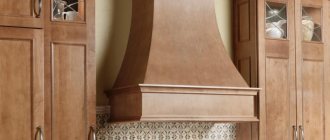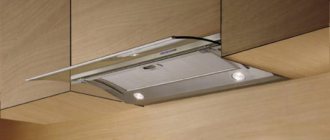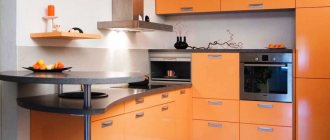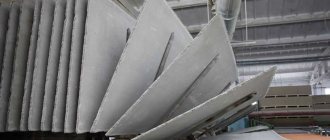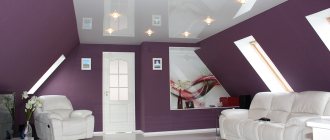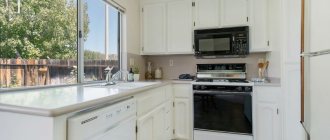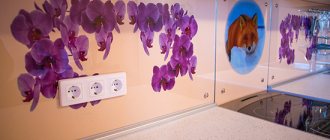A kitchen hood is used to clean the air collected above the stove from particles of dust and grease, processed gas, and soot. And the height of the hood above a gas stove and other types of cooking surfaces affects the quality of operation of the device and its efficiency.
How to correctly calculate the height between the hood and the stove? What affects height? Are there any standards? And what happens if they are not followed? We will consider all these issues in detail in our article, focusing on the types of hoods for the kitchen and the rules for carrying out calculations and measurements.
Types of kitchen hoods
Hoods are used to forcefully remove combustion products, various impurities (nitrogen oxide, carbon dioxide, various carcinogens) and unpleasant odors that appear in the air during cooking. This system operates on the principle of a vacuum cleaner.
A standard hood consists of the following elements: housing, electric motor, air intake, ventilation system, grease (sometimes carbon) filters.
An island hood is an ideal solution for large kitchens, as well as wide stoves and hobs. In this situation, it is important to take into account the height of the cook
Depending on the method of removing processed air, devices can be either circulating or flow-through . In the first case, the air, after purification and filtration, again enters the room, and in the second, it is discharged outside. Circulating ones are suitable if there is no ventilation in the house.
Not long ago, hoods began to appear that combine these two air handling technologies.
There are several types of hoods based on the installation method. Island ones , they are mounted on the ceiling. Corner ones are fixed in the corner of the kitchen. Such models are suitable for small kitchens.
As for installation, the built-in hood model can be easily hidden in a wall cabinet. Dome ones are mounted on the wall. They perfectly complement the interior, but often come in large sizes.
The built-in hood is suitable for kitchens of any size. It is mounted in a special cabinet. Furniture for this purpose is made to order or existing furniture is remodeled.
Air duct application
The hood is located far from the ventilation duct
The size and location of the hood is affected by the need to connect to the air duct. The best option is to place the device under the ventilation hole. This allows you to minimize the air duct route and increase the performance of air purification from contaminants.
It is not possible to implement such an installation in every kitchen. Then special pipes are used. In this case, it is also necessary to calculate their correct location so that the pipeline runs at a right angle and has a small number of bends.
Pipes made of aluminum or corrugated plastic are suitable for work. The diameter for kitchen hoods is 80, 100 and 129 mm. The cross-section can be square or round. Various connectors are used for connection. The cross-sectional dimensions of the air duct and the outlet pipe must match so that the contact is safe and reliable, and the removal of contaminated air is stable.
Pipes can be installed in a hidden or open way. In the second case, repair and maintenance are easier, but fixation will be required approximately every meter. Brackets and clamps are used for connection. A valve is also installed in the shaft to prevent foreign odors from penetrating back into the room.
General recommendations for safe installation
But in order for any model of hood to work efficiently and fulfill its functions, it must be installed correctly. This task is best left to professionals.
So, the following factors influence the height of the hood:
- standard recommendations;
- type of stove or hob;
- the presence or absence of ventilation, as well as its power;
- device performance;
- hood dimensions;
- user height.
Since the main task of the device is to purify the air above the hob, when calculating the height you should base it, first of all, on the type and size of the stove itself.
There are stoves: gas, electric, induction and halogen. A special feature of the latter are Hi-Light burners.
To operate effectively, the hood must completely cover the hob area. Thanks to this, all polluted air will be recycled. If the stove is wider, then harmful impurities and unnecessary odors will remain in the kitchen.
For fire safety reasons, standard height parameters between the hood and the burners have been developed.
When compiling them, the type of stove and the design of the lower part of the hood are taken into account. It can be straight or inclined.
For gas stoves, the height from the burners to the straight hood is from 75 to 85 cm, and to the inclined hood – 55-65 cm.
For electric, induction and halogen surfaces, the height from the burners to the direct hood is from 65 to 75 cm, and to the inclined hood – from 35 to 45 cm.
This difference in height is explained by the absence or presence of open fire and the risk of ignition of fat and soot particles on the filters
Often the manufacturer himself prescribes the required height. This is dictated by the characteristics of the materials from which the filters and the device itself are made. The material may be particularly flame resistant and/or have some special features.
You can deviate from the established standards by a maximum of 5-10 centimeters. The distance can only be increased, and reduced only if the power allows and the height of the cook requires it. In any case, before making a final decision, you should consult a specialist.
Professional installation will allow the device to perform its functions better and more efficiently (to extract all excess and purify the air), and will also save energy, since you will not have to turn on the hood at maximum power.
In addition, the height between the hood and the hob is affected by the performance of the hood itself. Sometimes this indicator is called power and is measured in cubic meters. m/hour. Before purchasing a hood, it is worth calculating at least an approximate value.
The quality of air purification directly depends on productivity. Also, if the device has sufficient power, you can adjust the height of the hood above the hob.
It is worth noting that power is also affected by the presence or absence of ventilation and the number of family members who smoke. Additional creases and right angles of the duct can only reduce the performance and increase the noise of the hood
No. 1 - installing a hood over a gas stove
There are many requirements for appliances that are installed above a gas stove. First, you need to accurately measure the distance from the bottom of the device to the hob. As mentioned above, it should be within 75-85 cm.
This distance is slightly greater than when installing the device above an electric model due to the fact that an open flame can ignite the hood filters, especially if they are heavily dirty.
Also, we should not forget that in the case of gas stoves, natural ventilation must work. Therefore, during installation, you cannot completely block the ventilation hole in the kitchen.
To avoid this, you can purchase special grilles for air ducts, divided into two parts: one for connecting the hood, and the other for natural ventilation.
The extraction power is also a very important parameter. Before purchasing a unit, it is necessary to accurately calculate it. A little below will be written about how to do this correctly.
Having carried out the necessary calculations and measurements, it is worth remembering that you cannot buy a device with less power than that obtained in the calculations. Otherwise, it will just be money thrown away; such a device will not cope with the task assigned to it
Do you want to install a hood over a gas stove yourself? In this case, we recommend watching the step-by-step installation instructions.
No. 2 - distance to the electric stove
More lenient requirements are being put forward for electric models. First of all, this concerns the installation height of the hood above the device - it can be reduced slightly, since these models are considered safer to use than gas models.
If the kitchen space is small, then the best option would be to opt for a built-in or flat hood model. In addition to convenience, the prices for such devices are affordable for most citizens.
Another important factor that needs to be taken into account when placing the device above the hob is the dimensions of the stove. So, the width and length of the hood should not be less than the same parameters of the slab. Otherwise, grease and soot will accumulate on the furniture.
We have provided detailed instructions for installing a kitchen hood yourself in this article.
The hood above an electric stove can be placed a little lower than above a gas stove, since the former are a little safer to use
At what distance should the hood be installed?
The sanitary standard and the technical passport for the equipment determine the distance from the gas stove to the hood - at least 65 cm. This is the manufacturer’s standard. The maximum distance from the gas stove to the cabinet with built-in ventilation is 85 cm, but it is a recommendation. It can be increased by installing more powerful equipment, and thereby ensure complete air purification.
Recommended distances
The minimum distance from the hood to the stove with electric burners, without an open flame, is 5 cm less. Filtration method: recirculation or with outlet to ventilation, this does not affect the established norms of the lower horizontal.
Built-in horizontal models are installed at a distance specified for wall-mounted and hanging models, namely: from electric stoves - at least 60 cm, from gas stoves - 65 cm.
Air filter location diagram according to standards
It is necessary to take into account
To correctly calculate the distance from the hob to the air intake, you need to consider:
- power;
- Type of equipment;
- location of the air intake plane – inclined or horizontal;
- type of stove;
- the height of the hostess.
At what distance to hang a kitchen air filter above the stove depends on the power of the hood. When installing low-power circulation-type models, maintain the minimum permissible distance. They are suitable for kitchens up to 10 m2.
Basic rules and regulations
Fireplace hoods can be hung higher than recommended by standards. Such models are characterized by a large air intake area, high performance and power. They have 4 fans that drive the air flow through the filters and discharge it into the exhaust duct. At the same time, the cleaning of a kitchen of any size and the dining room combined with it is carried out efficiently. Not only above the stove, but also from the entire room, air with soot, grease and steam is discharged into the exhaust system.
Recirculation-type installations filter air masses and return them in purified form back to the kitchen. They are suitable for small rooms where it is difficult to provide air flow from outside. In fact, only mechanical impurities and water remain on the filters. Carbon dioxide comes back. Oxygen levels in the air remain low.
Before choosing an air filter model, you should consider the size of the kitchen. It is also necessary to correctly determine its location. It is important at what distance from the stove the ventilation equipment is installed. The power of the device is determined by the volume of air in the room where it is installed.
Options and standards
Experts recommend purchasing hoods with one fan for small rooms; its operation is sufficient to clean the kitchen 10–12 times per hour.
The location of the bottom horizontal of the device is selected to be minimal for the existing hob.
The volume of a large room requires powerful equipment. The ventilation device in the kitchen is hung at the maximum distance from the stove surface recommended in the technical data sheet of this model.
Standard sizes
For ease of use of the equipment, the installation of a hood in the kitchen is carried out taking into account the height of the housewife. The front edge of the panel should not touch the head when a person leans over food being prepared on the stove. You shouldn’t hang the hood very high above the stove; it’s enough at the level of a raised half-bent arm. While cooking, you can easily switch ventilation modes without distraction.
Ergonomics experts recommend positioning the hood taking into account the height of the person who stands most near the stove. They calculated the most convenient size of the filter device from the floor of the bottom panel at a distance: human height minus 35 cm. The standards established by GOST should not be violated; they are based on the safe operation of the equipment.
Watch a useful video on this topic below.
Carrying out measurements and calculations
As you can see, it is quite difficult to take into account all the factors and make an accurate calculation. But you need to try not to regret purchasing a device that cannot cope with the tasks assigned to it.
There are criteria developed by manufacturers:
- A device with a capacity of 200 to 300 cubic meters. m/hour is suitable for those who cook little or have a small kitchen. That is, 1-2 burners are constantly used.
- Hood with a capacity of 300 to 400 cubic meters. m/hour is recommended for families of 3-4 people, or for a medium-sized kitchen, as well as where 2-3 burners are used daily.
- A device with a capacity of 500-600 cubic meters. m/hour will clean the air in a large kitchen and cover the needs of a large family. Such a hood will be indispensable if the stove is actively used every day and all burners are turned on (there may be 5-6 of them).
For approximate indicators, you can use special tables or data from manufacturers.
To quickly calculate productivity, two values are used: kitchen area and ceiling height. These approximate data can be multiplied by the slab coefficient
If the kitchen has non-standard dimensions or its area does not exceed 40 cubic meters. m, then calculate this value for a specific room by simply multiplying the length of the kitchen by its width and the height of the ceilings. The result must be multiplied by 10 or 12
The numbers 10 or 12 are constant coefficients based on sanitary standards. They mean that the air must be cleaned every 5 minutes, that is, 10-12 times per hour. Therefore, productivity exceeds the volume of the kitchen by at least 10-12 times.
Sometimes this coefficient increases due to the frequency of switching on and the characteristics of the stove used. For example, for a gas stove with large burners that are turned on every day, this number can reach 20. For an electric stove, you can take a factor of 15.
If the stove is non-standard and is cooked daily, then to calculate productivity it is worth using additional coefficients for the number of floors, for the stove, for smokers. But you should not purchase a device with a large power reserve
For example, the length and width of the kitchen are 2 and 3 m, respectively, and the ceiling height is 2.5 m.
Therefore, the estimated productivity will be: 2 * 3 * 2.5 * 10 = 150 cubic meters. m/hour .
This figure can be multiplied by the number of storeys factor of 1.3. It meets sanitary standards.
If someone smokes in the kitchen, then another 15% is added to productivity for each smoker of the total number.
The data obtained is correct for enclosed spaces. If the kitchen is not closed by a door, but is separated from other rooms by a passage, then another 30% of the received power should be added.
On our website we have detailed instructions for calculating a kitchen hood.
The next indicator is the height of the cook . It is very important that the hood does not touch your head and does not interfere with reaching distant burners or placing large pans.
Therefore, before purchasing and installing, take measurements and simulate the process of working behind the stove. To avoid mistakes when taking measurements, remember that an inclined hood should be measured from the lowest point to the burners.
All straight hoods (dome or built-in) should be measured from the filters to the slab surface.
Experts recommend choosing inclined hoods for electronic, halogen and induction cookers. They do not require much space and do an excellent job of purifying the air.
You should also take into account the length of the hood . Determine how far it will protrude above the hob, how convenient it will be to cook and replace charcoal and grease filters, as well as wash the stove and reach distant burners.
All described factors affecting the distance must be consistent. Otherwise, there is a risk that the hood will not cope with its tasks. Even the most powerful device installed too high will not cope with all the impurities in the air. Or soot that has settled on the bottom of a hood that is installed too low may ignite.
A competent choice of installation height will extend the life of the hood and allow the device to work at full capacity with minimal costs. In the worst case, the device may not cope with its functions or simply burn out.
What else to consider during installation?
Before installation, you should consider the specifics of connecting the device to the network.
Any hood is connected to the electrical network. Therefore, the socket should be installed at a height of 2 -2.5 meters from the floor and 15-25 cm above the wall cabinets.
Such an outlet must be grounded so that the hood does not burn out due to power surges. Never install an outlet in line with an air duct. Aim for about 15-20 cm from it.
Also, when taking measurements, it is worth considering the distances to the side cabinets. Aim for 5-10 cm in both directions.
We have provided diagrams of the location of sockets in the kitchen and the details of their installation with our own hands in the following material.
When making calculations, it is very important to take into account all pieces of furniture and wiring in the kitchen and draw a diagram of the location of each item
For example, let's look at a specific situation. The dome hood must be installed above a 5-burner gas stove in a 31-cu.m. kitchen. m, ceiling height 2.8 m. Cooking is done on the stove every day, the kitchen is closed with a door.
First, let's find out the approximate power. Let’s take the coefficient 20 due to the number of burners and the frequency of use of the stove: 31 * 2,8 * 20 = 1736.
Thus, this kitchen requires a hood with a capacity of at least 1800 cubic meters. m/hour.
The stove will be used by a person with a height of 170 cm, the height of the stove is 75 cm, and the height of the hood is 60 cm. Therefore, we compare all the data and get an approximate range of 77-80 cm for the height of the hood.
It is important to carry out such calculations to avoid errors during installation. But it’s best if you have the opportunity to check the conventional arrangement of equipment in the kitchen and the ease of its use.
Device installation rules
The hood, which filters the air and returns it back, is easy to install. You can install it above an electric stove yourself.
- It is necessary to draw a horizontal line above the hob at the height of equipment installation - the distance between the gas stove and the hood.
- A vertical line is drawn on the wall in the center of the slab. The standard provides rules for installing the hood exactly above the hob.
- The template from the packaging is applied to the lines, and 4 points are marked - the locations of the mounting bolts. Depending on the model, the distance between them is set as standard 200×200 or 200×100 mm.
- Make holes, hammer in dowels and screw in screws.
- The design without a filter grille and housing is hung on the wall.
- Install the remaining parts of the mechanism.
Spacious kitchen with electric stove
In cases where you purchase a hood with air exhaust into a ventilation pipe or chimney, the structure itself with fans is mounted on the wall in the same way as a model with a circulation method of air purification. Then you need to install the air duct, taking into account the minimum distance from the hood to the gas or electric stove. For normal ventilation, in order to prevent the effect of recirculation, that is, the return of air masses from the ventilation ducts back into the pipe, it is advisable to invite specialists.
Basic requirements for the air duct:
- the cross-section of the pipe is designed to allow air masses to pass through it at maximum equipment performance;
- the safety factor is taken into the formula for a specific design;
- the optimal distance to the outer wall or ventilation duct should be no more than 5 m;
- a maximum of 3 bends are allowed in the duct;
- pipes of different sections are unsuitable for the exhaust structure;
- All turns are made smooth, from radii.
At the stage of planning the placement of equipment in the kitchen, the stove should be placed closer to the outer wall or opposite the ventilation ducts in an apartment building.
Kitchen with gas stove in a country house
The socket must be grounded and located on the side of the edge of the hood body at a distance of 25 cm. The safest option is to install a switch that can quickly turn off the equipment.
Conclusions and useful video on the topic
From the video you can find out at what height you should install the hood and why it is important to adhere to these standards:
Calculating the required height of the hood above the surface of the slab is important for each case. Use the tips given in the article, do the calculations and then there will always be fresh and clean air in your kitchen .
Do you still have questions after reading our publication? Ask them in the comments block - our experts will try to help you.
Or maybe you have comments, additions, or have you noticed inaccuracies in the material presented above? Please write to us about this below the article.


